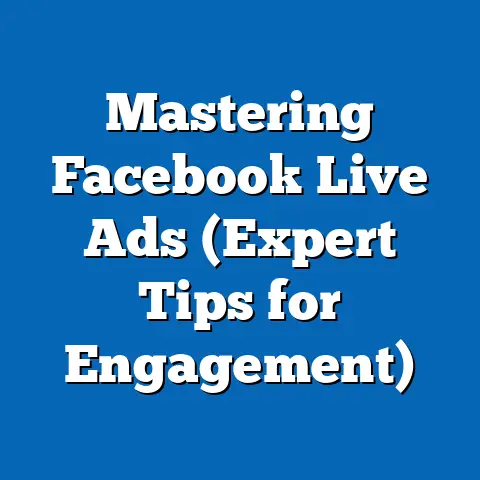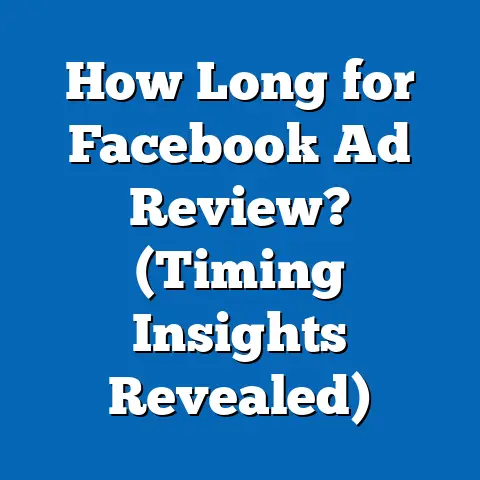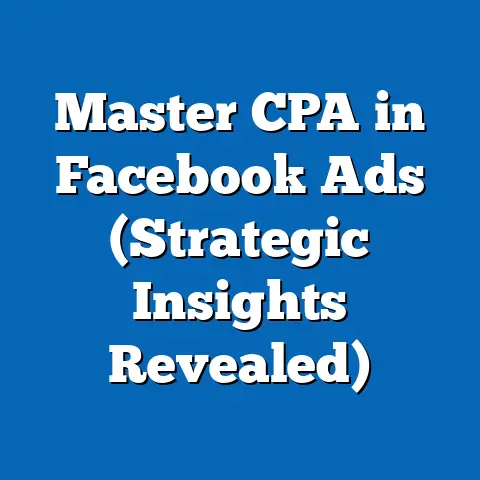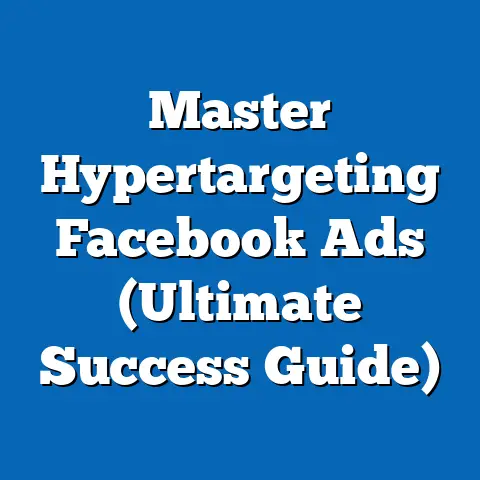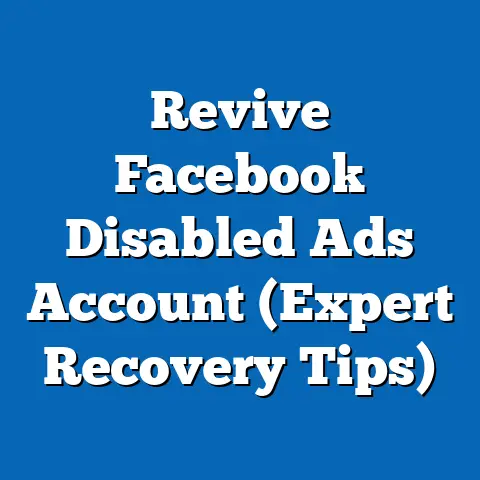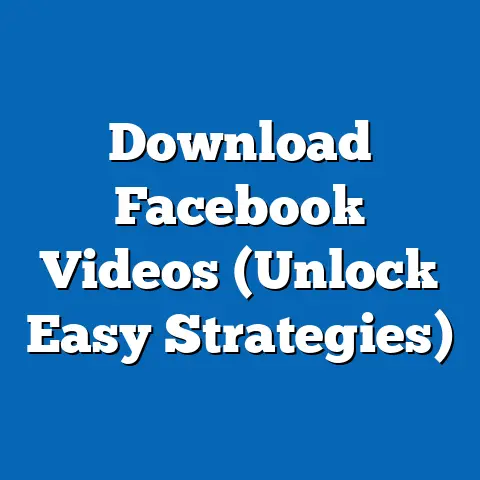Master Facebook Ads to Boost Business (Proven Strategies)
In an era where digital advertising dominates marketing budgets, a striking paradox emerges: while businesses invest billions in online ads, many struggle to achieve meaningful returns. According to a 2023 report by eMarketer, global digital ad spending reached $626 billion, with Facebook (now Meta) commanding a 21.9% market share, second only to Google. Yet, a survey by HubSpot revealed that 63% of small-to-medium businesses (SMBs) report underwhelming results from their Facebook ad campaigns, often citing poor targeting and high costs as barriers.
This paradox—massive investment with inconsistent outcomes—underscores the need for strategic mastery of Facebook Ads. With over 2.9 billion monthly active users as of 2023 (Statista), Facebook remains a goldmine for businesses, but only for those who navigate its complexities with precision. This article delves into proven strategies to optimize Facebook Ads, backed by data-driven insights, demographic trends, historical comparisons, and forward-looking projections.
Section 1: The Power of Facebook Ads in Today’s Market
Facebook Ads have become a cornerstone of digital marketing due to their unparalleled reach and targeting capabilities. As of 2023, businesses of all sizes spent over $137 billion on Meta’s advertising platforms, with SMBs accounting for nearly 60% of this expenditure (eMarketer). The platform’s ability to micro-target audiences based on demographics, interests, and behaviors makes it a powerful tool for driving conversions.
However, the sheer volume of advertisers—over 10 million active advertisers in 2023 (Meta)—creates fierce competition. Ad costs have risen significantly, with the average cost-per-click (CPC) increasing by 17% year-over-year to $0.97 in 2023 (WordStream). This rising cost underscores the importance of strategic ad creation to maximize return on investment (ROI).
Section 2: Demographic Breakdowns—Who’s Clicking and Converting?
Understanding the demographic landscape of Facebook users is critical to crafting effective ad campaigns. As of 2023, 18-34-year-olds constitute 54% of Facebook’s user base, making them the largest demographic (Statista). However, the 35-54 age group shows higher engagement rates, with 62% interacting with ads compared to 48% of younger users (Hootsuite).
Gender also plays a role in ad performance. Men make up 56% of users but are 12% less likely to click on ads than women, who demonstrate higher conversion rates in e-commerce and lifestyle categories (Social Media Today). Geographically, North America accounts for only 10% of users but generates 45% of ad revenue due to higher purchasing power and ad spend per user (Meta Q3 2023 Report).
Businesses targeting Gen Z (18-24) must note their preference for visual content—video ads achieve 35% higher engagement among this group compared to static images (Sprout Social). Meanwhile, Baby Boomers (55+) are a growing segment, with user numbers increasing by 20% since 2019, and they show a 28% higher likelihood of engaging with local business ads (Pew Research). Tailoring content to these demographic nuances is a proven strategy for boosting ad performance.
Section 3: Historical Trends—How Facebook Ads Have Evolved
To appreciate the current state of Facebook Ads, a look at historical data reveals significant shifts in usage and effectiveness. In 2012, when Facebook first rolled out its advertising platform widely, the average CPC was just $0.24, and businesses primarily used the platform for brand awareness with basic image ads (WordStream). By 2017, as video content surged, CPC rose to $0.64, and advertisers began leveraging retargeting and custom audiences, with conversion rates improving by 40% compared to earlier years (eMarketer).
The introduction of the Facebook Pixel in 2015 marked a turning point, allowing businesses to track user behavior and optimize campaigns for specific actions like purchases or sign-ups. By 2020, despite privacy changes like Apple’s iOS 14 update impacting tracking, advertisers adapted by focusing on first-party data, with 73% reporting improved ROI through lookalike audiences (Forbes). Today, in 2023, the average conversion rate for Facebook Ads stands at 9.21%, a stark contrast to 2.5% in 2012, reflecting advancements in targeting and ad formats (WordStream).
However, ad fatigue has grown over time. In 2015, only 18% of users reported annoyance with repetitive ads; by 2023, this figure climbed to 41% (Statista). This trend highlights the need for fresh, creative content to maintain user engagement.
[Insert Chart: Historical CPC and Conversion Rates for Facebook Ads, 2012-2023]
Section 4: Proven Strategies to Master Facebook Ads
4.1: Precision Targeting with Custom and Lookalike Audiences
One of the most effective strategies for maximizing ROI is leveraging Facebook’s custom and lookalike audience features. Custom audiences allow businesses to target users based on past interactions, such as website visits or email lists, with campaigns using this feature seeing 37% higher click-through rates (CTR) than broad targeting (Meta Business Insights). Lookalike audiences, which target users similar to existing customers, boost conversion rates by 25% on average (WordStream).
For example, an e-commerce brand can upload a list of past buyers to create a custom audience, then use a lookalike audience to reach potential customers with similar behaviors. This dual approach minimizes wasted ad spend and focuses on high-intent users.
4.2: Optimizing Ad Creative for Engagement
Creative content is the backbone of successful Facebook Ads. Video ads, which now account for 54% of all impressions on the platform, generate 6x higher engagement than static images (Hootsuite). Short, impactful videos (under 15 seconds) perform best, with 82% of users watching them to completion (Sprout Social).
Additionally, incorporating user-generated content (UGC) in ads increases trust and engagement by 50% compared to branded content (Nielsen). Businesses should also A/B test ad copy and visuals, as campaigns with consistent testing report 30% higher ROI (WordStream). For instance, testing carousel ads against single-image ads can reveal which format resonates more with a target audience.
4.3: Budget Allocation and Bidding Strategies
Effective budget management is crucial in the competitive Facebook Ads ecosystem. The average small business allocates $1,000-$2,000 monthly to Facebook Ads, yet 45% overspend due to inefficient bidding (HubSpot). Using automated bidding strategies like “lowest cost” or “target cost” can reduce CPC by up to 20% while maintaining performance (Meta Ads Manager).
Seasonal trends also impact budgeting. For instance, CPC spikes by 45% during the holiday season (Q4), so businesses should plan for higher costs or shift focus to less competitive niches (WordStream). Setting daily budgets and monitoring frequency (the average number of times a user sees an ad) prevents oversaturation—keeping frequency below 4 maximizes engagement (Social Media Examiner).
4.4: Retargeting to Re-Engage Lost Leads
Retargeting remains a powerhouse strategy, with 70% of users who abandon a shopping cart returning to complete a purchase after seeing a retargeted ad (Criteo). By installing the Facebook Pixel, businesses can track users who visit their site and serve them tailored ads, increasing conversion rates by 43% compared to non-retargeted campaigns (WordStream).
A practical approach is to segment retargeting audiences based on behavior—for instance, offering a discount to users who added items to their cart but didn’t check out. This personalization drives a 29% higher likelihood of conversion (Meta Business Insights).
4.5: Leveraging Advanced Analytics for Continuous Improvement
Data is the lifeblood of successful ad campaigns. Facebook’s Ads Manager provides detailed metrics like CTR, conversion rate, and cost-per-acquisition (CPA), which businesses must analyze weekly to optimize performance. Campaigns that adjust based on analytics see a 33% improvement in ROI within the first month (Forbes).
Third-party tools like Google Analytics can complement Facebook data by tracking post-click behavior, revealing insights into user journeys. For example, if 60% of clicks from a campaign drop off at the checkout page, businesses can address friction points like slow load times or unclear calls-to-action (CTAs).
[Insert Chart: Impact of Retargeting on Conversion Rates, 2020-2023]
Section 5: Contextual Factors Shaping Facebook Ad Performance
Several external factors influence the effectiveness of Facebook Ads, beyond strategy and execution. Privacy regulations, such as the General Data Protection Regulation (GDPR) in Europe and California’s Consumer Privacy Act (CCPA), have restricted data collection, with 27% of advertisers reporting reduced targeting accuracy since 2021 (eMarketer). Apple’s iOS 14.5 update, which introduced App Tracking Transparency, further impacted performance, with Meta estimating a $10 billion revenue loss in 2022 due to signal loss (Meta Q1 2022 Report).
Economic conditions also play a role. During inflationary periods, such as 2022-2023, consumer spending dropped by 8% in key markets like the U.S., leading to lower ad conversion rates in retail and discretionary categories (U.S. Bureau of Economic Analysis). Conversely, sectors like health and wellness saw a 15% uptick in ad engagement as consumers prioritized essentials (Statista).
Platform algorithm changes are another factor. Facebook’s 2018 shift to prioritize “meaningful interactions” over branded content reduced organic reach for businesses by 50%, pushing more reliance on paid ads (Social Media Today). Staying updated on such changes is essential for maintaining campaign effectiveness.
Section 6: Future Projections—What Lies Ahead for Facebook Ads?
Looking forward, the trajectory of Facebook Ads suggests both challenges and opportunities. eMarketer projects global digital ad spending to reach $740 billion by 2025, with Meta’s share growing to 23% as it innovates with augmented reality (AR) and virtual reality (VR) ad formats. Immersive ads in the Metaverse could drive engagement by 40% among younger demographics by 2027 (Forbes).
However, rising privacy concerns may further limit targeting capabilities. By 2025, 60% of global internet users are expected to opt out of data tracking, forcing advertisers to rely on contextual targeting and first-party data (Gartner). Businesses that build robust customer databases now will have a competitive edge.
Ad costs are also projected to rise, with CPC potentially reaching $1.20 by 2025 due to increased competition and inflation (WordStream). SMBs may need to explore alternative platforms like TikTok, where CPC is currently 30% lower, though Facebook’s vast user base will likely keep it dominant (eMarketer).
On the innovation front, AI-driven ad tools are expected to revolutionize campaign management. Meta’s Advantage+ automation suite, launched in 2022, has already improved ad efficiency by 32% for early adopters, and further advancements could democratize high-performing ads for smaller businesses by 2026 (Meta Business Blog).
Conclusion: Mastering the Art and Science of Facebook Ads
The paradox of Facebook Ads—massive potential paired with frequent underperformance—can be resolved through strategic mastery. By leveraging precision targeting, compelling creative, smart budgeting, retargeting, and data analytics, businesses can transform their ad campaigns into powerful revenue drivers. Demographic insights reveal the importance of tailoring content to specific age groups, genders, and regions, while historical trends show how far the platform has come—and how much room for innovation remains.
As privacy regulations tighten and ad costs rise, adaptability will be key. Businesses that stay ahead of trends, embrace automation, and prioritize user trust will thrive in the evolving landscape. With global ad spend on Meta platforms projected to grow, mastering Facebook Ads today is not just a competitive advantage—it’s a business imperative.

